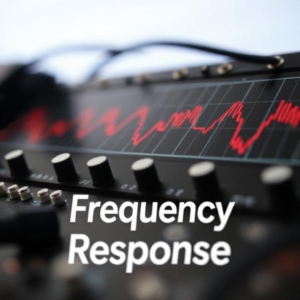What is Frequency Response?
- Frequency Response refers to how an electronic component or system reacts to different frequencies of an input signal. In simple terms, it’s about how well the component or circuit can handle signals of different frequencies (like low, medium, or high-pitched sounds) and how it affects those signals as they pass through.
- Frequency refers to the number of times a signal oscillates or repeats per second, measured in Hertz (Hz). For example, a 50 Hz signal means it repeats 50 times per second, and a 1000 Hz signal repeats 1000 times per second.
- When we talk about frequency response, we’re interested in how much a circuit or component amplifies or reduces signals at different frequencies.

How Does Frequency Affect Components?
Different electronic components behave differently at various frequencies. The response of each component will depend on the frequency of the input signal. Let’s look at how some common components respond.
1. Resistors:
- Behavior with Frequency: A resistor’s behavior doesn’t really change with frequency. Whether the signal is low-frequency (e.g., a slow signal like a DC signal) or high-frequency (e.g., a fast-changing AC signal), a resistor will behave the same way.
- Frequency Response: The frequency response of a resistor is flat, meaning it will allow all frequencies to pass through without changing the signal.
2. Capacitors:
- Behavior with Frequency: Capacitors store electrical energy and then release it. Their behavior changes significantly with frequency.
- At low frequencies, capacitors act like open circuits (they resist the flow of current).
- At high frequencies, capacitors act like short circuits (they allow current to pass more easily).
- Frequency Response: The higher the frequency, the more a capacitor “allows” current to flow through. For low-frequency signals, the capacitor resists the flow, and the output signal is weaker.
3. Inductors:
- Behavior with Frequency: Inductors resist changes in current flow and store energy in magnetic fields. Like capacitors, inductors also react differently at different frequencies.
- At low frequencies, inductors act like short circuits (they allow current to pass through easily).
- At high frequencies, inductors act like open circuits (they resist the current flow more).
- Frequency Response: As the frequency increases, the inductor’s impedance (resistance to current) also increases. So, at high frequencies, the inductor blocks more current.
4. Active Components (Transistors, Operational Amplifiers):
- Behavior with Frequency: Active components like transistors and op-amps (operational amplifiers) amplify signals. Their frequency response can change with the frequency of the signal.
- These components typically perform best at certain frequencies and may not amplify signals as effectively at very low or very high frequencies. This is because they have internal limitations that cause their performance to degrade outside a certain frequency range.
- Frequency Response: They usually have a bandwidth — a range of frequencies where they can operate effectively. Beyond that range, their ability to amplify signals decreases.
What is a Bode Plot?
A Bode plot is a graph that shows how the frequency response of a system or component behaves. It’s often used to analyze how much the amplitude (signal strength) and phase (timing of the signal) change at different frequencies.
- Amplitude Response (magnitude) shows how much the signal is amplified or attenuated (reduced) at different frequencies.
- Phase Response shows how much the timing (phase) of the signal is shifted at each frequency.
In a Bode plot, the x-axis represents frequency, and the y-axis represents either the amplitude or the phase shift. The plot helps us see how the system or component affects the signal at different frequencies.
Types of Frequency Responses:
- Low-Pass Filter:
- Allows low frequencies to pass through but attenuates (reduces) high frequencies.
- Example: A capacitor in series with a resistor can act as a low-pass filter, where higher frequencies are blocked.
- High-Pass Filter:
- Allows high frequencies to pass through but attenuates low frequencies.
- Example: A capacitor in parallel with a resistor can act as a high-pass filter, allowing higher frequencies to pass.
- Band-Pass Filter:
- Allows a specific range (band) of frequencies to pass while attenuating both lower and higher frequencies.
- Example: A combination of inductors and capacitors in a circuit can create a band-pass filter.
- Band-Stop Filter:
- Blocks a specific range of frequencies and allows frequencies outside that range to pass.
- Example: A combination of inductors and capacitors can create a band-stop filter.
Practical Example: Audio Systems
In an audio system, the frequency response of the components (like speakers, amplifiers, and filters) is important for determining how they reproduce sounds. Different components handle different frequencies well, so the frequency response of the entire system ensures that all the sounds, from bass (low frequencies) to treble (high frequencies), are heard clearly.
- Speakers have a frequency response range, and they can produce low-frequency sounds (bass) and high-frequency sounds (treble) within that range.
- Equalizers adjust the frequency response of audio systems, allowing you to boost or cut specific frequency ranges to enhance the sound.
Summary:
- Frequency response is how electronic components or circuits behave with signals of different frequencies.
- Resistors have a flat response (they don’t change with frequency).
- Capacitors and inductors change their behavior depending on the frequency, and they are often used to filter signals.
- Active components like transistors and operational amplifiers have limited bandwidth and their performance degrades outside a certain frequency range.
- Bode plots are used to graph the frequency response of systems.
- Different components (like filters) are used to let certain frequencies pass and block others.
This is the basic idea of how frequency response works with electronic components! Let me know if you want more details or examples!











